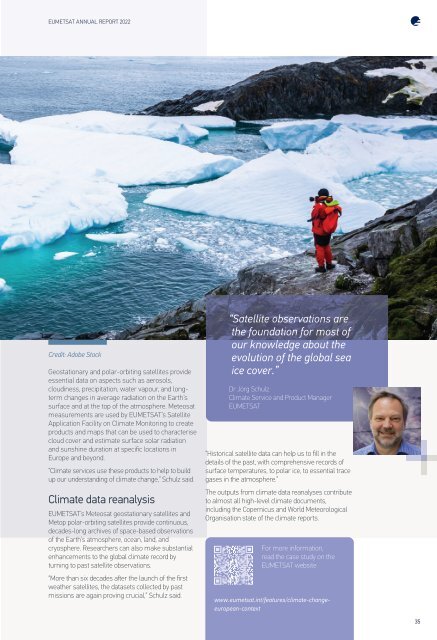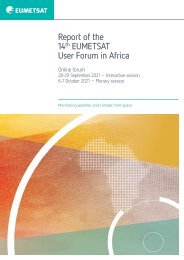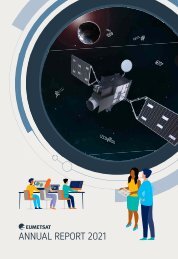EUMETSAT Annual Report 2022
Create successful ePaper yourself
Turn your PDF publications into a flip-book with our unique Google optimized e-Paper software.
<strong>EUMETSAT</strong> ANNUAL REPORT <strong>2022</strong><br />
Credit: Adobe Stock<br />
Geostationary and polar-orbiting satellites provide<br />
essential data on aspects such as aerosols,<br />
cloudiness, precipitation, water vapour, and longterm<br />
changes in average radiation on the Earth’s<br />
surface and at the top of the atmosphere. Meteosat<br />
measurements are used by <strong>EUMETSAT</strong>’s Satellite<br />
Application Facility on Climate Monitoring to create<br />
products and maps that can be used to characterise<br />
cloud cover and estimate surface solar radiation<br />
and sunshine duration at specific locations in<br />
Europe and beyond.<br />
“Climate services use these products to help to build<br />
up our understanding of climate change,” Schulz said.<br />
Climate data reanalysis<br />
<strong>EUMETSAT</strong>’s Meteosat geostationary satellites and<br />
Metop polar-orbiting satellites provide continuous,<br />
decades-long archives of space-based observations<br />
of the Earth’s atmosphere, ocean, land, and<br />
cryosphere. Researchers can also make substantial<br />
enhancements to the global climate record by<br />
turning to past satellite observations.<br />
“More than six decades after the launch of the first<br />
weather satellites, the datasets collected by past<br />
missions are again proving crucial,” Schulz said.<br />
“Satellite observations are<br />
the foundation for most of<br />
our knowledge about the<br />
evolution of the global sea<br />
ice cover.”<br />
Dr Jörg Schulz<br />
Climate Service and Product Manager<br />
<strong>EUMETSAT</strong><br />
“Historical satellite data can help us to fill in the<br />
details of the past, with comprehensive records of<br />
surface temperatures, to polar ice, to essential trace<br />
gases in the atmosphere.”<br />
The outputs from climate data reanalyses contribute<br />
to almost all high-level climate documents,<br />
including the Copernicus and World Meteorological<br />
Organisation state of the climate reports.<br />
For more information,<br />
read the case study on the<br />
<strong>EUMETSAT</strong> website<br />
www.eumetsat.int/features/climate-changeeuropean-context<br />
35









